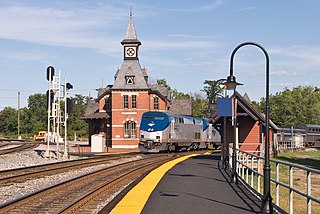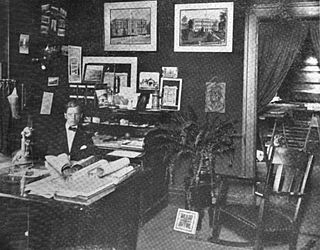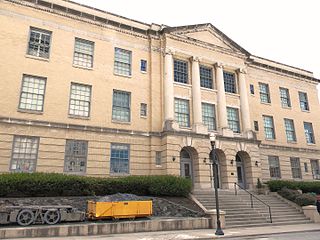
Rivesville is a town and former coal town in Marion County, West Virginia, United States. The population was 934 at the 2010 census.

Frank Heyling Furness was an American architect of the Victorian era. He designed more than 600 buildings, most in the Philadelphia area, and is remembered for his diverse, muscular, often unordinarily scaled buildings, and for his influence on the Chicago architect Louis Sullivan. Furness also received a Medal of Honor for bravery during the Civil War.

Peabody & Stearns was a premier architectural firm in the Eastern United States in the late 19th century and early 20th century. Based in Boston, Massachusetts, the firm consisted of Robert Swain Peabody (1845–1917) and John Goddard Stearns Jr. (1843–1917). The firm worked on in a variety of designs but is closely associated with shingle style.

The Western Maryland Railway was an American Class I railroad (1852–1983) which operated in Maryland, West Virginia, and Pennsylvania. It was primarily a coal hauling and freight railroad, with a small passenger train operation.

Ephraim Francis Baldwin was an American architect, best known for his work for the Baltimore and Ohio Railroad and for the Roman Catholic Church.

Horace Trumbauer was a prominent American architect of the Gilded Age, known for designing residential manors for the wealthy. Later in his career he also designed hotels, office buildings, and much of the campus of Duke University. Trumbauer's massive palaces flattered the egos of his "robber baron" clients, but were dismissed by his professional peers. His work made him a wealthy man, but his buildings rarely received positive critical recognition. Today, however, he is hailed as one of America's premier architects, with his buildings drawing critical acclaim even to this day.

G. W. & W. D. Hewitt was a prominent architectural firm in the eastern United States at the turn of the twentieth century. It was founded in Philadelphia in 1878, by brothers George Wattson Hewitt (1841–1916) and William Dempster Hewitt (1847–1924), both members of the American Institute of Architects. The firm specialized in churches, hotels and palatial residences, especially crenelated mansions such as Maybrook (1881), Druim Moir (1885–86) and Boldt Castle (1900–04). The last was built for George C. Boldt, owner of Philadelphia's Bellevue-Stratford Hotel (1902–04), G.W. & W.D. Hewitt's most well-known building.

Fairmont Senior High School, is a public high school in Fairmont, West Virginia. The current school building, opened in 1928, is listed on the National Register of Historic Places. Serving grades nine through twelve, it is one of three high schools in Marion County, along with East Fairmont High School and North Marion High School.
Wilson Brothers & Company was a prominent Victorian-era architecture and engineering firm established in Philadelphia, Pennsylvania, that was especially noted for its structural expertise. The brothers designed or contributed engineering work to hundreds of bridges, railroad stations and industrial buildings, including the principal buildings at the 1876 Centennial Exposition. They also designed churches, hospitals, schools, hotels and private residences. Among their surviving major works are the Pennsylvania Railroad, Connecting Railway Bridge over the Schuylkill River (1866–67), the main building of Drexel University (1888–91), and the train shed of Reading Terminal (1891–93), all in Philadelphia.

William Butts Ittner was an architect in St. Louis, Missouri. He designed over 430 school buildings in Missouri and other areas, was president of the St. Louis Chapter of the American Institute of Architects from 1893 to 1895, was awarded an honorary degree by the University of Missouri in 1930, served as president of the Architectural League of America during 1903–04, and at the time of his death was president of the St. Louis Plaza Commission, a fellow and life member of the American Institute of Architects, and a thirty-third degree Mason. He was described as the most influential man in school architecture in the United States and has a star on the St. Louis Walk of Fame. He was appointed St. Louis School Board commissioner in 1897 and is said to have designed open buildings that featured "natural lighting, inviting exteriors, and classrooms tailored to specific needs." In 1936, Ittner died. His legacy is survived by the William B. Ittner, Inc. and Ittner & Bowersox, Inc. architecture firms in St. Louis.

Alexander Blount Mahood was a Bluefield, West Virginia-based architect.

Leon Emil Dessez was an American architect in Washington D.C. He designed public buildings in Washington D.C. and residences in Washington D.C., Maryland, and Virginia, including some of the first in Chevy Chase, Maryland, where he was the community's first resident. His work includes the 1893 the conversion of 1111 Pennsylvania Avenue, The Shepherd Centennial Building, into the Raleigh Hotel and the Normal School for Colored Girls (1913), designed with Snowden Ashford.

Albert W. Fuller (1854-1934) was an American architect practicing in Albany, New York.

Edwin Thomas Banning (1864–1940) was an American architect from Providence, Rhode Island.

Charles W. Bates (1879–1929) was an American architect who practiced primarily in Wheeling, West Virginia, and was one of the region's most successful architects. He mostly specialized in commercial and school buildings in the north Ohio River valley.

Garry & Sheffey was a prominent architectural firm from Bluefield, the largest city in southern West Virginia. The named partners were Martin J. Garry and Robert A. Sheffey, who established their partnership in 1920. The firm was active until 1941, and locally was second only to that of Alex. B. Mahood.

Ernest C. S. Holmboe was an American architect, practicing in Chicago, Illinois, Marietta, Ohio, and Clarksburg, West Virginia.

Hassel T. Hicks (1896–1952) was an American architect from Welch, West Virginia.

Thomas Sylvester Riley was an American lawyer, politician, and businessperson who was based in West Virginia. Riley was the state's eleventh attorney general from March 4, 1893, until March 3, 1897.




















